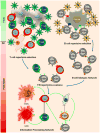The immune system as a self-centered network of lymphocytes
- PMID: 26092524
- PMCID: PMC4501489
- DOI: 10.1016/j.imlet.2015.06.002
The immune system as a self-centered network of lymphocytes
Abstract
This essay makes a brief historical and comparative review of selective and network theories of the immune system which is presented as a chemical sensory system with immune and non-immune functions. The ontogeny of immune networks is the result of both positive and negative selection of lymphocytes to self-epitopes that serve as a "template" for the recognition of foreign antigens. The development of immune networks progresses from single individual clones in early ontogeny into complex "information processing networks" in which lymphocytes are linked to inhibitory and stimulatory immune cells. The results of these regulatory interactions modulate immune responses and tolerance.
Keywords: Autoimmunity; B cells; Immune networks; Immunology; Self-peptides; T cells.
Copyright © 2015 European Federation of Immunological Societies. Published by Elsevier B.V. All rights reserved.
Figures

References
-
- Ehrlich P. Croonian lecture – on immunity with special reference to cell life. Proc R Soc Lond. 1900;66:424–448.
-
- von Behring E, Kitasato S. Ueber das Zustandekommen der Diphtherie-Immunitat und der Tetanus-Immunitat bei Thieren. Deut Med Wochenschr. 1890;16:1113–1114.
-
- Ehrlich P, schutzstoffe des Blutes Die. Verh 73 Ges Dtsch Naturforsch Arzt. 1901;27:865–867. 88–91, 913–916.
-
- Donath J, Landsteiner K. Ueber paroxysmale Hamoglobinurie. Much Med Wochenschr. 1904;51:1590–1593.
-
- Landsteiner K. The Specificity of Serological Reactions. Dover, New York: 1962.
Publication types
MeSH terms
Substances
Grants and funding
LinkOut - more resources
Full Text Sources
Other Literature Sources
Medical

